I have been doing some research and wondered if anyone might have some examples (pictures) of Byzantine swords. But pictures are a little hard to come by for swords of Byzantine origin (pictures of originals, not in the Osprey series, etc.).
Any examples of straight or curved xiphos, the spathion or the later paramerion would be greatly appreciated!
:cool:
Hi
It will be hard to find much? Apart from mosiac and MS pictures.
I have a couple of pics for you though.
N
 Attachment: 81.85 KB
Attachment: 81.85 KB
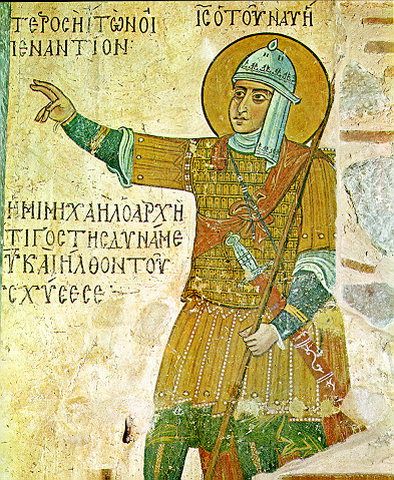
It will be hard to find much? Apart from mosiac and MS pictures.
I have a couple of pics for you though.
N

spatha
 Attachment: 21.81 KB
Attachment: 21.81 KB
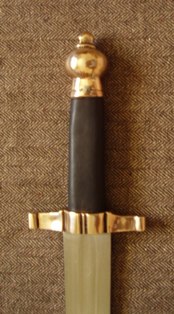

close up
 Attachment: 65.82 KB
Attachment: 65.82 KB


Byzantine swords of the 10th century or earlier might still have a very " Roman " character to them but I wonder if around the 14th century a lot of the military equipment like swords might be very close to the Western European styles and types popular at the time ? ( Maybe still with a lot of Oriental influences and older Byzantine aesthetics. )
I don't know, just a thought?
So from lets say from 1000 A.D. to 1453 A.D. would Byzantine military equipment / arms / armour have become very close to mainstream European or remained very distinctively Byzantine ? ( Or maybe gone the other way and become more and more Oriental ? :eek: :lol: )
I don't know, just a thought?
So from lets say from 1000 A.D. to 1453 A.D. would Byzantine military equipment / arms / armour have become very close to mainstream European or remained very distinctively Byzantine ? ( Or maybe gone the other way and become more and more Oriental ? :eek: :lol: )
My understanding is that from 1000 - 1453, the weaponry would have continued to be fairly uniform until the late 1000's (post Manzenkirt) as the thematic armies would have been similarly supplied and the Varangians were supplied from the imperial armories. Later, mercenaries made up a growing majority of the Byzantine forces, and since many of them came from Western Europe, I imagine the later Byzantine edged weapons would have been mixed with what we see in Western Europe as well as the curved weapons of the East. Certainly the Paleologi period (late 1300s - 1453) was different from the Heraculian dynasty (600s)
I have some icons as well of some weapons, but given how stylized they are, am not sure they are a really accurate representation. I will try to post some of those later today. :cool:
I have some icons as well of some weapons, but given how stylized they are, am not sure they are a really accurate representation. I will try to post some of those later today. :cool:
Sorry a few wall pics and MS pics is all I have.
N
N
Here are some images of warrior saints - from St. Demetrios, circa 1000, to various images of St. George in a later period and style.
 Attachment: 48.04 KB
Attachment: 48.04 KB
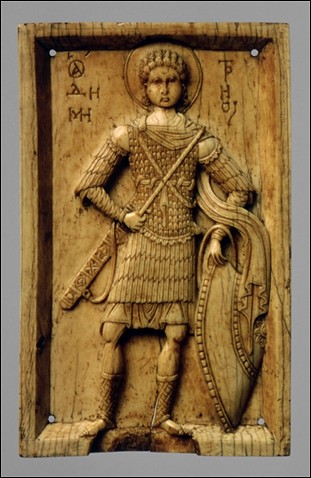

Continued from previous post.
I do hope, even if there are no pictures out there of original Byzantine weapons, that folks don't mind this.
:cool:
 Attachment: 110.7 KB
Attachment: 110.7 KB
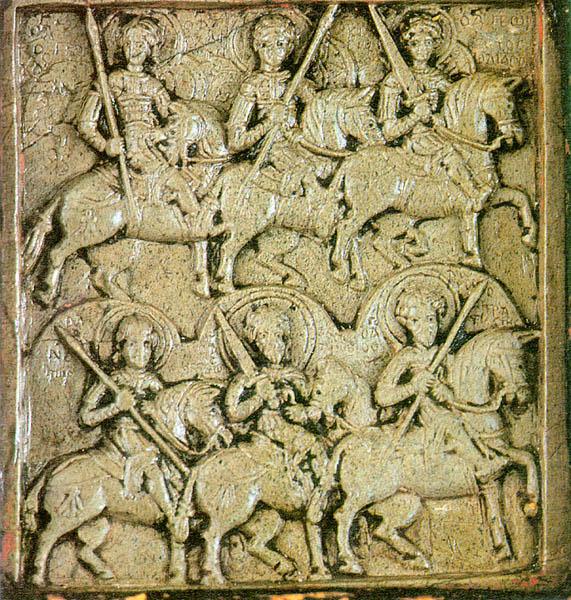
I do hope, even if there are no pictures out there of original Byzantine weapons, that folks don't mind this.
:cool:

And finally a couple of different images of St. George.
 Attachment: 21.51 KB
Attachment: 21.51 KB
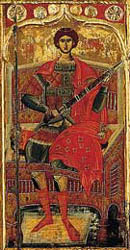
 Attachment: 12.57 KB
Attachment: 12.57 KB
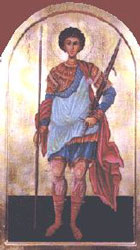
 Attachment: 17.53 KB
Attachment: 17.53 KB
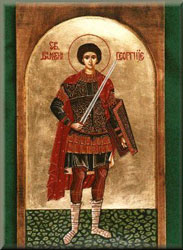



I am posting these pictures in this thread in the hopes that someone might be able to give me a bit more information about each of them. Would either of these weapons have been similar to those in the kit of Eastern armies?
 Attachment: 38.51 KB
Attachment: 38.51 KB
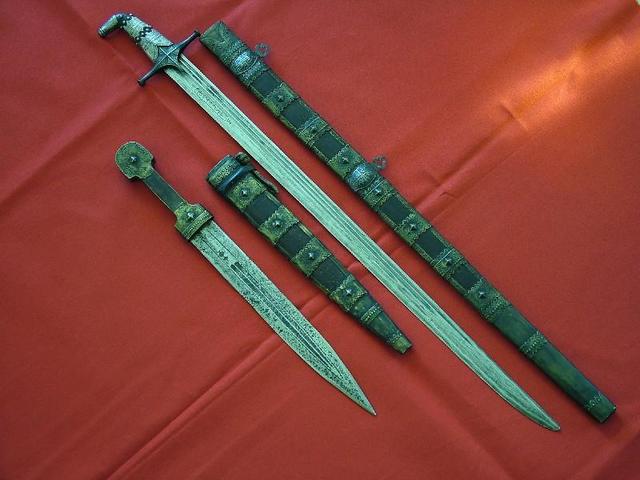
 Attachment: 30.47 KB
Attachment: 30.47 KB
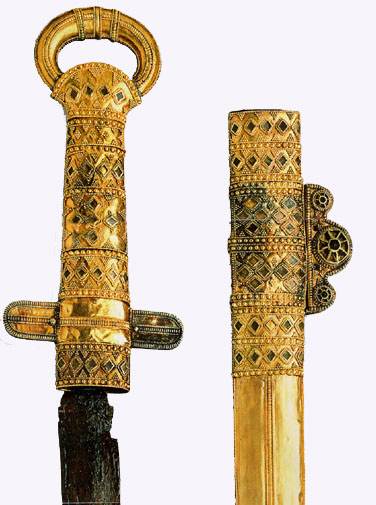


In the first picture, I think it's a Georgian sabre and a georgian kindjal and in the second it could be a short scythian or sarmatian ring pommel sword but without a picture of the whole weapon I can't be sure.
The second one is a sword from Malaya Pereshtchepina (sp?) and is date - late 7th, or the beginning of 8th C.
In the treasure were found two rings bearing monograms,which were read "Kkubratu" and "kubratu patriciu". This led historians to believe it might be connencted to the ruler of Great Bulgaria Kubrat.
As for byzantine swords - Wallpaintings and manuscripts from 12th-15th centuries show swords which appear to be identical to western ones. The other weapon that can be seen is a single-edged curved sword
In the treasure were found two rings bearing monograms,which were read "Kkubratu" and "kubratu patriciu". This led historians to believe it might be connencted to the ruler of Great Bulgaria Kubrat.
As for byzantine swords - Wallpaintings and manuscripts from 12th-15th centuries show swords which appear to be identical to western ones. The other weapon that can be seen is a single-edged curved sword
As far as I've been told by my friends that have visited the region, there is quite a lot of byzantine stuff in Middle Eastern museums. However, this is rarely available online, it appears.
That is apparently true, as I am finding a lot of iconography, but very little by way of military artifact. However, the spheres of overlap with the Byzantine political and cultural influence are quite deep and thus both these weapons appear to be within that for the period of say 700 to 1100. Hence my question.
Also, when I review the art record, I find not just Western weapons depicted, but weapons in a similar style (as in the previous pictures posted in the thread). Hopefully not a short lived fishing expedition!! Thanks for the input! :cool:
Also, when I review the art record, I find not just Western weapons depicted, but weapons in a similar style (as in the previous pictures posted in the thread). Hopefully not a short lived fishing expedition!! Thanks for the input! :cool:
First of all i would like to greet all the members..since it's my first post! :)
To the point,i ve never come across a byzantine sword.
Just several depictions..
I would add that additionally to the main "spathion" and "paramerion" types , another term is used in the sources ,probably (and i will explain the "probability" and not "certainty" ) to describe a certain type of spathion.
It is the "Rhomphaia" (romfea).We could call it "byzantine romphaia" to distinguish it from the original thracian of the first cent BC-first cent AD.
Quotes in the Sources:
1)Michael Psellus ,Chronographia ,Book 7 (11th cent)
" the palace guards.**273 (These men are, without exception armed with shields and the rhomphaia, a one-edged sword of heavy iron which they carry suspended from the right shoulder.) "
[219] Some were armed with swords, others with the heavy iron rhomphaia, others with lances."
2)Eustathius of Thessalonica (12th cent)
In his comments abt Iliad VI 166.
3)Anna Komnene's The Alexiad. (11th-12th cent)
She describes the Varangians surrounding the Emperor “some with xiphê (plural) girded on, some carrying spears and some having on their shoulders the heavy iron rhomphaia”
Some argued that this Romphaia was actually the ancient romfaia of the Thracians.
I believe this hypothesis is really weak for several reasons. First,it would be quiet impossible a continuous use of the weapon ,from the 3rd cent AD to the 11th cent,without any reference in the sources.
Besides there is not a single depiction of such a weapon. Finally we must focus in a highly important aspect:the extreme attention Byzantine paid on Religion.
"Rhomphaia" is repeatedly mentioned in the Gospels (written in 1st cent AD) as the weapon of archangel Michael,and a "weapon of justice".Byzanines probably used this term ,borrowing it from the Holy scripts to describe this type of sword.
To the point,i ve never come across a byzantine sword.
Just several depictions..
I would add that additionally to the main "spathion" and "paramerion" types , another term is used in the sources ,probably (and i will explain the "probability" and not "certainty" ) to describe a certain type of spathion.
It is the "Rhomphaia" (romfea).We could call it "byzantine romphaia" to distinguish it from the original thracian of the first cent BC-first cent AD.
Quotes in the Sources:
1)Michael Psellus ,Chronographia ,Book 7 (11th cent)
" the palace guards.**273 (These men are, without exception armed with shields and the rhomphaia, a one-edged sword of heavy iron which they carry suspended from the right shoulder.) "
[219] Some were armed with swords, others with the heavy iron rhomphaia, others with lances."
2)Eustathius of Thessalonica (12th cent)
In his comments abt Iliad VI 166.
3)Anna Komnene's The Alexiad. (11th-12th cent)
She describes the Varangians surrounding the Emperor “some with xiphê (plural) girded on, some carrying spears and some having on their shoulders the heavy iron rhomphaia”
Some argued that this Romphaia was actually the ancient romfaia of the Thracians.
I believe this hypothesis is really weak for several reasons. First,it would be quiet impossible a continuous use of the weapon ,from the 3rd cent AD to the 11th cent,without any reference in the sources.
Besides there is not a single depiction of such a weapon. Finally we must focus in a highly important aspect:the extreme attention Byzantine paid on Religion.
"Rhomphaia" is repeatedly mentioned in the Gospels (written in 1st cent AD) as the weapon of archangel Michael,and a "weapon of justice".Byzanines probably used this term ,borrowing it from the Holy scripts to describe this type of sword.
How would Romphaia sword look like?
The sources tell us it was:
iron , one-edged ,long/heavy.
The sources also describe two "units" using it..:
Guards of the emperor,and especially Varangians and...Angels..and especially archangel Michael.
The image of Michael(St.Marco treasury) in the prev posts and this of Mt Athos (11th cent) below,may give us a picture of this long,straight,single edged sword.
[img][ Linked Image ]
[/img]
Also this mosaic of a Varangian guard with his Byzantine clothing and his heavy sword may depict a Romphaia (Nea Moni,Chios island c.1040-50)
[img][ Linked Image ]
[/img]
The sources tell us it was:
iron , one-edged ,long/heavy.
The sources also describe two "units" using it..:
Guards of the emperor,and especially Varangians and...Angels..and especially archangel Michael.
The image of Michael(St.Marco treasury) in the prev posts and this of Mt Athos (11th cent) below,may give us a picture of this long,straight,single edged sword.
[img][ Linked Image ]
[/img]
Also this mosaic of a Varangian guard with his Byzantine clothing and his heavy sword may depict a Romphaia (Nea Moni,Chios island c.1040-50)
[img][ Linked Image ]
[/img]
Thanks so much for posting in the thread!
That is interesting as I had not thought of the Romphaia being depicted (as I hadn't seen someone point it out before). I went back and examined your pictures and can see what you mean. I had thought along the lines of something like the Albion Berserker (Viking type H), with the single edge, but now can see it from the examples you posted.
Very interesting. What is interesting to me is that the Byzantines had such a wide medieval footprint, and armouries producing weapons for thematic armies, etc. that we don't see many examples of their weaponry. For example, coins, jewelry, etc. there are many many pieces, but I am wracking my brain to find examples of these Byzantine weapons.
:cool:
That is interesting as I had not thought of the Romphaia being depicted (as I hadn't seen someone point it out before). I went back and examined your pictures and can see what you mean. I had thought along the lines of something like the Albion Berserker (Viking type H), with the single edge, but now can see it from the examples you posted.
Very interesting. What is interesting to me is that the Byzantines had such a wide medieval footprint, and armouries producing weapons for thematic armies, etc. that we don't see many examples of their weaponry. For example, coins, jewelry, etc. there are many many pieces, but I am wracking my brain to find examples of these Byzantine weapons.
:cool:
Page 1 of 4
You cannot post new topics in this forumYou cannot reply to topics in this forum
You cannot edit your posts in this forum
You cannot delete your posts in this forum
You cannot vote in polls in this forum
You cannot attach files in this forum
You can download files in this forum
All contents © Copyright 2003-2006 myArmoury.com — All rights reserved
Discussion forums powered by phpBB © The phpBB Group
Switch to the Full-featured Version of the forum
Discussion forums powered by phpBB © The phpBB Group
Switch to the Full-featured Version of the forum